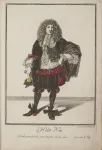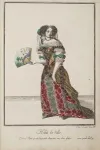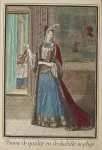(Press-News.org) University of Cambridge media release
UNDER STRICT EMBARGO UNTIL 00:01AM (UK TIME) ON MONDAY 22ND JULY 2024
A collection of French fashion engravings offers precious new insights into the life of Samuel Pepys years after his premature final diary entry. The prints show the tailor’s son remained fascinated by the power of fashion long after he had secured wealth and status. But they also expose Pepys’ internal conflict over French style.
Most of what we know about Samuel Pepys (1633–1703), the famous English diarist and naval administrator, comes from the diary that he kept from 1660–69. He wrote about everything from women to parmesan cheese, and the Great Fire of London, but he also wrote a lot about clothes. However, Pepys lived for another 34 years and while surviving letters offer clues, we know less about the second, more privileged half of his life.
University of Cambridge historian Marlo Avidon reveals fascinating new insights having studied Pepys’ private collection of fashion prints in the Pepys Library at Magdalene College, Cambridge, where Pepys had been a student. 2024 marks the 300th anniversary of Magdalene acquiring Pepys’ private library including his original diaries.
The library contains one of the largest bound collections of 17th-century French fashion prints in the world. Avidon, a PhD researcher at Christ’s College, Cambridge, focuses on two of its volumes, the Habits de France and Modes de Paris, which comprise over a hundred fashion illustrations printed between 1670 and 1696.
Appearing today in the journal The Seventeenth Century, Avidon’s article publishes eight images from the collection for the first time. Avidon links one of these images to a cringe-worthy episode in Pepys’ diary.
In 1669, Pepys wrote that he was ‘afeared to be seen’ in a summer suit he had just bought ‘because it was too fine with the gold lace at the hands’. Finally he plucked up the courage but a socially superior colleague spotted him in the park and told him the sleeves were above his station. Pepys decided ‘never to appear in Court’ with the sleeves and made a tailor cut them off, ‘as it is fit I should.’
Pepys learnt a lesson that day but this didn’t put him off fashion. He went on to buy a print entitled ‘Habit Noir’ (evening wear) which shows an elite Frenchman proudly showing off very similar lace cuffs as well as plentiful ribbons.
“Pepys would have seen this outfit as pretty risky,” Marlo Avidon said. “This was for a French courtier, and was probably well beyond his budget. But Pepys probably did own suits with these kinds of ribbon loops, just not so many as this. This is how fashion worked and still works today – you demonstrate your knowledge of style within your means.”
“Pepys felt he had to walk a really fine line, especially early in his career. His father was a tailor, his mother a washerwoman, and throughout his life Pepys was profoundly worried about how he was perceived and took steps to manage his image. The diary shows his anxieties as a young adult. The prints show that his determination to prove himself, using clothes and cultural capital, continued throughout his life.”
Pepys rose to be the Chief Secretary to the Admiralty in 1673 and was first elected as an MP in 1679.
Avidon said: “Pepys stopped writing his diary just as his career was taking off. It’s really challenging to access Pepys' later life. These prints provide a unique opportunity to consider his attitudes to fashion in this period.”
Pepys’ initial print purchases and close observation of his superiors in the civil service, detailed in his diary, show him attempting to access lofty social circles, Avidon argues.
But as Pepys expanded his print collection, he was part of a network of gentleman scholars linked to the Naval Office and Royal Society.
“He started to use fashion to solidify his social position and demonstrate his cosmopolitan tastes,” Avidon said, “but collecting fashion prints was also a way to cement intellectual relationships and maintain his scholarly reputation.”
“I went into this research with a lot of reservations about Pepys, I didn't like him. But the prints offer a much more nuanced picture of him, a more human picture. He was fallible and anxious and his actions in response to that anxiety feel quite familiar today.”
A guilty pleasure
Avidon’s research suggests that Pepys never shook off his worries about dressing inappropriately, making a fashion faux pas, or the moral dilemma of wearing designs imported from France.
“There was concern about the relationship Charles II was fostering with the Catholic French King Louis XIV and about growing French influence on English culture. This created a sense of moral crisis. There was particular anxiety in England about Popery and its association with vanity,” Avidon said.
French clothes were often viewed in England as being scandalously excessive as they combined luxury silks with over-the-top trim and lace, and huge statement accessories.
“Pepys had a French wife, was friends with French merchants and had a keen interest in French culture,” Avidon said. “But Pepys also ridiculed people returning from France wearing over-the-top French fashions and he had a preoccupation with French elites being frivolous.”
“Pepys felt under pressure to maintain the moral high ground, not just by wearing clothes appropriate for his own social station but also to uphold what was appropriate for his country morally and economically.”
In his diary, Pepys condemned the English Queen’s Maids of Honour for wearing French-inspired masculine-inspired riding habits, writing ‘nobody could take them for women in any point whatever – which was an odde sight, and a sight did not please me.’
A year earlier, however, he thought the opposite, noting ‘it was pretty to see the young pretty ladies dressed like men’. And Pepys later purchased a French print showing an evolved version of this style featuring a martial style coat.
“When it came to women’s clothes, Pepys’s taste and attitudes were constantly changing and often conflicting,” Avidon said.
Pepys’ fashionable women
When viewed together, Pepys’ diary and print collection emphasise that women bore the brunt of accusations of vanity and excessive consumption but fashion still remained a very masculine concern in this period.
Pepys’ French wife Elizabeth died in 1669, aged 29, shortly before Pepys started collecting his fashion prints.
“Pepys’ diary suggests he really loved his wife and he wanted her to dress well,” Avidon said. “But he worried about her overspending on clothes and sometimes went shopping with her. Pepys kept Elizabeth in a state of fashion limbo as he did himself.”
References in Pepys’ diary suggest that Elizabeth was interested in prints herself and Avidon believes that she influenced what Pepys went on to collect.
Elizabeth died soon after a trip with Pepys’ to Paris in May 1669. We don’t know much about their stay but they almost certainly shopped for prints – because Pepys’ friend John Evelyn advised him on how to do it – and perhaps clothes too.
“Pepys was distraught by Elizabeth’s death,” Avidon said. “I think these prints of fashionable young women must have reminded Pepys of Elizabeth. The collection could be seen as an homage to her.”
Pepys soon employed a teenage housekeeper, Mary Skinner, who swiftly became his mistress. They stayed together until his death and she was often referred to as Mrs Pepys. We know very little about Mary but Avidon believes that the print collection could bring us much closer to her.
Pepys took a leading role in Mary’s education, moulding her as a refined gentlewoman as he had Elizabeth, and Avidon suggests that he may have given Mary black and white fashion prints to colour.
“Some of the prints were clearly not professionally coloured, they look amateurish,” Avidon said. “Pepys acquired these prints over the course of his relationship with Mary. It’s quite possible that he was teaching her how to colour these prints. We’ll never know for sure, but by the time Mary died, she had become a fairly fashionable woman in her own right.”
In ‘Habit Noir’, Avidon points to unprofessional white gaps in the colouring. In other prints, the colouring bleeds over lines obscuring clothing details. In ‘Habit de ville’, a print depicting a fashionable city gown, someone has coloured the embroidered silk pattern with amateurish squiggly lines. Avidon suggests that both prints could conceivably have been coloured by Mary Skinner.
Avidon studied Pepys’ print collection as part of her PhD research into the role of fashion in the identity construction of elite women in the late 17th Century.
“The Pepys Library is a very intimate space to research in,” Avidon said. “Pepys’ diary is in a display case right next to you and you're surrounded by bookcases filled with his treasured possessions. I was so excited. Pepys would have taken these prints out and talked to friends about them. Now I get to do that.”
Reference
M. Avidon, ‘“Instructive Types” or Mere “Fancies”: Assessing French Fashion Prints in the Library of Samuel Pepys’, The Seventeenth Century (2024). DOI: 10.1080/0268117X.2024.2373990
Media contacts
Tom Almeroth-Williams, Communications Manager (Research), University of Cambridge: researchcommunications@admin.cam.ac.uk / tel: +44 (0) 7540 139 444
Marlo Avidon, University of Cambridge: mea47@cam.ac.uk
END
Samuel Pepys’ fashion prints reveal his guilty pleasure: Fancy French clothes
2024-07-22
ELSE PRESS RELEASES FROM THIS DATE:
New genetic test will eliminate a form of inherited blindness in dogs
2024-07-22
Progressive retinal atrophy (PRA) is a group of inherited diseases that causes progressive degeneration of the light sensitive cells at the back of the eye. Dogs with PRA have normal sight at birth, but by the age of four or five they will be totally blind. There is no treatment.
Now a team led by the University of Cambridge has identified the genetic mutation that causes PRA in English Shepherd Dogs, and developed a DNA test for it. By identifying dogs carrying the disease before their eyesight starts to fail, this provides a tool to guide breeding decisions so the disease is not passed on to puppies.
Owners usually don’t realise their dog has PRA until it is ...
Cancer risk: Most Australian welders exposed to high levels of dangerous fumes
2024-07-21
New Curtin University research has revealed at least 46,000 Australian welders are exposed to high levels of dangerous, potentially cancer-causing fumes at work — and little is being done to protect them.
A joint Curtin School of Population Health and University of Sydney project funded through the Centre for Work Health and Safety, the Australian-first study was published today in the Australian and New Zealand Journal of Public Health.
The research team surveyed 634 workers and employers involved in welding from across Australia ...
Two-in-one mapping of temperature and flow around microscale convective flows
2024-07-20
Tokyo, Japan – Researchers from Tokyo Metropolitan University have devised a way to measure both the temperature and velocity profiles of fluid in a convective plume at millimeter length scales in 3D. They combined near-infrared absorption imaging and image processing to separate the motion of tracer particles from snapshots of how light is absorbed, producing both a smooth velocity and temperature map. The technology promises new insights into optimizing the design of micro-heating and cooling devices.
Accurate maps of how heat and matter flow at the microscale are vital to the design of micro-heating and cooling devices. A classic example ...
Texas A&M engineers explore intelligence augmentation to improve safety
2024-07-20
Artificial intelligence (AI) has grown rapidly in the last few years, and with that increase, industries have been able to automate and improve their efficiency in operations.
A feature article published in AIChE Journal identifies the challenges and benefits of using Intelligence Augmentation (IA) in process safety systems.
Contributors to this work are Dr. Faisal Khan, professor and chemical engineering department head at Texas A&M University, Dr. Stratos Pistikopoulos, professor and director of the Energy Institute, Drs. Rajeevan Arunthavanathan, Tanjin Amin, and Zaman Sajid from the Mary Kay O’Connor Safety Center.
Additionally, Dr. Yuhe ...
ORNL economist honored at international hydropower conference
2024-07-19
Researcher Rocio Uria-Martinez was named one of four “Women with Hydro Vision” at this year’s HYDROVISION International 2024 conference taking place in Denver this week. Awarded by a committee of industry peers, the honor recognizes women who use their unique talents and vision to improve and advance the worldwide hydropower industry.
Uria is an energy and environmental economist and senior R&D staff member at the Department of Energy’s Oak Ridge ...
UCLA selected by Centers for Medicare & Medicaid Services to test Medicare dementia care model
2024-07-19
UCLA has been selected by the Centers for Medicare & Medicaid Services (CMS) to participate in a new Medicare alternative payment model designed to support people living with dementia and their caregivers.
UCLA is one of almost 400 participants building Dementia Care Programs (DCPs) across the country working under CMS’ Guiding an Improved Dementia Experience (GUIDE) Model to increase care coordination and improve access to services and supports, including respite care, for people living ...
Fish adjust reproduction in response to predators
2024-07-19
Some species of fish can evolve their egg-laying habits in response to predators in the area in order to survive, according to new research from The University of Texas at Arlington.
It has long been observed that organisms modify their traits, including reproductive patterns, in response to changes in their environment. This type of evolutionary plasticity has been observed in many types of animals in different habitats and with varying predators.
“We knew that fish who laid their eggs externally often adapted depending on the predators in the area, but we did not know how quickly species could change to these externals pressures,” said biology Professor Matthew Walsh, ...
DDX41 and its unique contribution to myeloid leukemogenesis
2024-07-19
“[...] myeloid neoplasms associated with DDX41 variants likely exhibit a unique pathogenesis that diverges from the conventional understanding of myeloid neoplasms.”
BUFFALO, NY- July 19, 2024 – A new editorial paper was published in Oncotarget's Volume 15 on July 2, 2024, entitled, “DDX41 and its unique contribution to myeloid leukemogenesis.”
In this new editorial, researcher Hirotaka Matsui from the National Cancer Center Hospital in Tokyo, Japan, and Kumamoto University discusses myeloid neoplasms. Until ...
Digital games on vaping devices could lure more youth to nicotine addiction
2024-07-19
RIVERSIDE, Calif. -- In an “Industry Watch” research paper in the journal Tobacco Control, two scientists at the University of California, Riverside, raise the alarm on new electronic cigarette products equipped with touch screens, animated displays, and built-in games. Because the products are user friendly and attractive to youth, they may couple nicotine addiction with gaming disorder, the researchers caution.
Of particular concern to the researchers is that coupling nicotine to existing youth behaviors, such as video gaming and screen time use, could broaden the smart electronic cigarette market to include youth with no prior interest in nicotine products, while ...
Cracking the code of hydrogen embrittlement
2024-07-19
When deciding what material to use for infrastructure projects, metals are often selected for their durability. However, if placed in a hydrogen-rich environment, like water, metals can become brittle and fail. Since the mid-19th century, this phenomenon, known as hydrogen embrittlement, has puzzled researchers with its unpredictable nature. Now, a study published in Science Advances brings us a step closer to predicting it with confidence.
The work is led by Dr. Mengying Liu from Washington and Lee University in collaboration with researchers at Texas A&M University. The team ...







